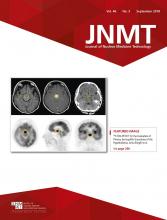Abstract
Because of better precision and intercompatibility, the use of lean body mass (LBM) as a mass estimate in the calculation of SUV (SUL) has become more common in research and clinical studies today. Thus, the equations deciding this quantity must be those that best represent the actual body composition. Methods: LBM was calculated for 44 patients examined with 18F-FDG PET/CT scans by means of the sex-specific predictive equations of James and Janmahasatians, and the results were validated using a CT-based method that makes use of the eyes-to-thighs CT component of the PET/CT aquisition and segments the voxels according to Hounsfield units. Intraclass correlation coefficients and Bland–Altman plots were used to assess agreement between the various methods. Results: A mean difference of 6.3 kg (limits of agreement, −15.1 to 2.5 kg) between  and
and  was found. This difference was higher than the 3.8-kg difference observed between
was found. This difference was higher than the 3.8-kg difference observed between  and
and  (limits of agreement, −12.5 to 4.9 kg). In addition,
(limits of agreement, −12.5 to 4.9 kg). In addition,  had a higher intraclass correlation coefficient with
had a higher intraclass correlation coefficient with  (0.87; 95% confidence interval, 0.60–0.94) than with
(0.87; 95% confidence interval, 0.60–0.94) than with  (0.77; 95% confidence interval, 0.11–0.91). Thus, we obtained better agreement between
(0.77; 95% confidence interval, 0.11–0.91). Thus, we obtained better agreement between  and
and  . Although there were exceptions, the overall effect on SUL was that
. Although there were exceptions, the overall effect on SUL was that  was greater than
was greater than  . Conclusion: We have verified the reliability of the suggested
. Conclusion: We have verified the reliability of the suggested  formulas with a CT-derived reference standard. Compared with the more traditional and available set of
formulas with a CT-derived reference standard. Compared with the more traditional and available set of  equations, the
equations, the  formulas tend to yield better agreement.
formulas tend to yield better agreement.
Footnotes
Published online Mar. 29, 2018.







